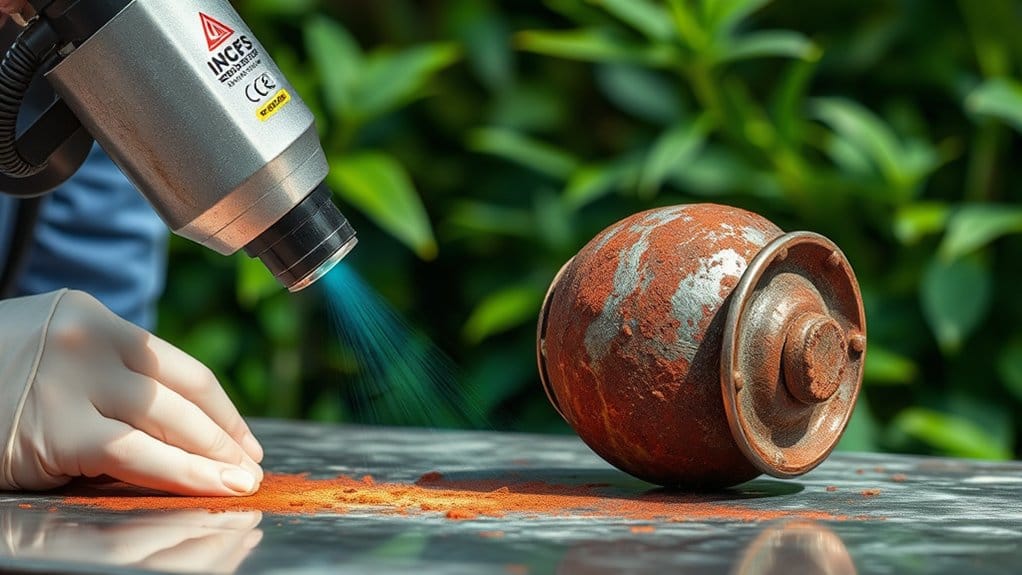Laser Cleaning Portugal is leading the way in sustainable cleaning solutions, offering significant environmental benefits.
By reducing harmful chemical use, we improve workplace safety and eliminate VOC emissions. Our laser cleaning technology vaporizes contaminants, minimizing waste and enhancing recyclability, which supports sustainability.
We conserve water by eliminating its use and lower energy consumption by up to 70%, aligning with climate goals. Our approach promotes clean air and preserves ecosystems, driving eco-friendly innovation.
At Laser Cleaning Portugal, we partner with industry leaders in construction, inspection, and manufacturing, ensuring substantial environmental impact and technological advancements.
Our collaboration with local educational institutions enables us to stay ahead in laser-based technology, providing unmatched services across Portugal.
Discover how Laser Cleaning Portugal’s initiatives contribute to a cleaner, greener future.
Key Takeaways
- Laser cleaning reduces harmful chemical usage, enhancing workplace safety and minimizing VOC emissions.
- It minimizes waste generation by eliminating secondary waste and preserving material integrity.
- The process conserves water by using no water and generating no wastewater.
- Laser systems are energy efficient, consuming up to 70% less energy than traditional methods.
- It supports eco-friendly technological innovation by reducing emissions and waste.
Reducing Harmful Chemical Usage

While traditional cleaning methods rely heavily on harmful chemicals, laser cleaning offers an attractive alternative by eliminating the need for such agents. This change to an environmentally friendly process greatly reduces the emission of volatile organic compounds (VOCs) and other contaminants. By avoiding these pollutants, laser cleaning promotes improved air and water quality, aligning with our commitment to environmental health and sustainability.
Moreover, traditional methods often expose operators to toxic substances, compromising safety. Laser cleaning enhances workplace safety by reducing this exposure. As we shift to this technology, we also reduce our ecological footprint, as it doesn’t produce secondary waste apart from the removed material. This positions laser cleaning as a sustainable choice, offering us greater freedom from the constraints of hazardous chemical usage.
Minimizing Waste Generation
When we consider the advantages of laser cleaning, minimizing waste generation stands out as a significant benefit. Traditional cleaning often results in hazardous waste due to chemical use, increasing environmental impact. In contrast, laser cleaning directly vaporizes or disintegrates contaminants without additional agents, leading to less waste. This method guarantees no secondary waste, simplifying disposal and reducing our ecological footprint. By using a focused laser beam, we effectively remove contaminants while preserving material integrity, minimizing material loss. Additionally, the recyclability of removed materials enhances sustainability across industries. Adopting laser cleaning allows us to reduce hazardous waste, align with eco-friendly practices, and maintain operational freedom without compromising efficiency or contributing to environmental degradation.
Enhancing Water Conservation

Laser cleaning emerges as an essential technology for enhancing water conservation in industrial settings. Unlike traditional methods, which guzzle water for rinsing and waste disposal, laser cleaning uses no water, greatly lowering our water footprint. This method eliminates the need for chemical agents that demand water for dilution or removal, offering clear environmental benefits. Additionally, it generates no wastewater, easing the load on treatment systems and conserving our important water resources.
- Reduces water usage: Laser cleaning uses no water, unlike abrasive blasting.
- Minimizes chemical reliance: No water is needed for chemical dilution.
- Supports sustainability: Aligns with global conservation efforts.
In applications like paint and rust removal, laser cleaning provides effective results without the extensive water usage associated with traditional methods.
Energy Efficiency in Cleaning Processes
In the quest for more sustainable industrial practices, energy efficiency plays an essential role, and laser cleaning emerges as a standout solution. Laser systems consume up to 70% less energy than traditional cleaning methods, which slashes operational costs while enhancing environmental protection. The high efficiency of lasers guarantees quick contaminant removal, reducing energy consumption across operations. Unlike conventional methods, laser cleaning skips chemical agents and abrasive materials, further cutting energy used in producing and disposing of these consumables. Operating with high power and low cost, laser technology offers an energy-efficient option for industries aiming for sustainability. By integrating advanced systems, we reduce greenhouse gas emissions, aligning with global climate goals through strategic energy use, thereby promoting freedom from environmental constraints.
Promoting Cleaner Air Quality

While traditional cleaning methods often exacerbate air pollution, laser cleaning offers an intriguing alternative by considerably reducing harmful emissions. By eliminating harsh chemical agents, laser technology minimizes volatile organic compounds (VOCs) and other pollutants contributing to poor air quality. Its focused energy pulses remove contaminants without releasing particulate matter or hazardous fumes, promoting ideal environmental conditions.
Consider the advantages:
- No secondary waste: Unlike traditional methods, laser cleaning generates no additional pollutants.
- Protection of ecosystems: The absence of chemical agents reduces air and water contamination risks.
- Compliance with regulations: Adopting laser cleaning aligns industries with air quality standards, benefiting communities and workers.
Supporting Sustainable Practices
Let’s investigate how laser cleaning reduces chemical dependency and minimizes our ecological footprint. By eliminating the need for chemical agents, we considerably cut down on VOCs and harmful emissions, aligning with sustainable practices. Additionally, laser cleaning’s energy efficiency and non-contact operation further decrease resource consumption and ecological disruption, supporting environmentally responsible initiatives.
Reducing Chemical Dependency
As we investigate ways to enhance sustainable practices, reducing chemical dependency emerges as an essential strategy. Laser cleaning offers a powerful alternative to traditional cleaning methods that rely heavily on harsh chemicals. By utilizing energy-efficient, focused laser beams, we considerably cut down on the use of harmful substances, promoting sustainability and freedom from chemical constraints. This approach not only conserves natural resources but also guarantees a safer environment for operators.
Key benefits include:
- Eliminating the release of volatile organic compounds (VOCs) and pollutants.
- Minimizing hazardous waste since no abrasive materials or residues are generated.
- Enhancing compliance with environmental regulations.
Minimizing Ecological Footprint
Building on our efforts to reduce chemical dependency, we focus on minimizing our ecological footprint through laser cleaning. This method effectively eliminates the reliance on chemical agents, which cleaning contributes to cleaner air and water by reducing pollutant emissions. Unlike traditional methods, laser cleaning generates no secondary waste aside from the removed material, resulting in far less environmental impact. Additionally, this process consumes less energy and resources, which aligns with our sustainability goals and reduces greenhouse gas emissions. By promoting the recyclability of removed materials, laser cleaning supports waste reduction and responsible resource reuse. This approach not only adheres to global initiatives for minimizing ecological damage but also enables industries to adopt eco-friendly practices without compromising efficiency and freedom.
Preserving Ecosystem Health

While traditional cleaning methods often rely on harsh chemicals that threaten our ecosystems, laser cleaning offers a sustainable alternative that safeguards environmental health. By eliminating the need for chemical agents, laser cleaning reduces the risk of emitting pollutants, ensuring cleaner air and water. This technology generates no secondary waste, minimizing landfill hazards and supporting healthier soil systems. Additionally, its efficiency lowers resource consumption, reducing operating costs and promoting ecological preservation.
Laser cleaning also prevents particulate release, protecting flora and fauna. This method supports conservation efforts, preserving both natural and cultural assets for future generations. Key benefits include:
- No chemical byproducts: Reduces environmental pollutants.
- Minimal waste generation: Lessens landfill impact.
- Preservation of ecosystems: Safeguards habitats and biodiversity.
Through these advantages, laser cleaning helps sustain ecosystem health.
Encouraging Technological Innovation
As we examine the role of laser cleaning in promoting technological innovation, it’s clear that this technology advances sustainable practices by eliminating the need for harmful chemical agents and reducing emissions. The focus on cleaner alternatives not only cuts down on waste and power consumption but also aligns with the rising demand for eco-friendly technologies. By encouraging the recycling of materials and minimizing surface damage, laser cleaning supports a circular economy, thereby nurturing innovation that prioritizes environmental sustainability.
Advancing Sustainable Practices
Laser cleaning technology stands at the forefront of advancing sustainable practices by markedly reducing environmental impact through innovative methods. Its uses offer significant advantages over traditional cleaning, primarily through:
- **Elimination of *hazardous chemicals***: This advantage reduces VOCs and harmful emissions.
- Minimal material waste: The ability to clean effectively via energy pulses vaporizes contaminants without secondary waste.
- Energy efficiency: Modern fiber laser systems consume up to 70% less power, lowering carbon footprints.
This technology stands out due to its non-contact nature, allowing precise contaminant removal, enhancing surface longevity, and reducing frequent replacements. Such advancements promote sustainable material use and align with global efforts to shift towards eco-friendly practices, supporting a future where resource conservation is prioritized without compromising technological progress.
Promoting Cleaner Alternatives
Embracing laser cleaning technology revolutionizes how we approach eco-friendly industrial processes by advocating for cleaner alternatives. Traditional chemical cleaning agents contribute to hazardous waste and VOC emissions, underlining the need for a shift. The advantages of laser cleaning are clear: it reduces reliance on consumables, ablates contaminants with precision, and aligns with our sustainability goals by minimizing the ecological footprint. Our focus on highly efficient processes is supported by laser systems that consume up to 70% less power compared to conventional methods, enhancing energy conservation. As industries adopt this innovative technology, we cultivate a culture prioritizing environmental stewardship. This not only encourages sustainable practices but also enables us to make conscious choices that align with our desire for freedom and ecological responsibility.
Boosting Eco-Friendly Technologies
When we examine the technological strides in industrial cleaning, it’s evident that laser cleaning stands at the forefront of eco-friendly innovation. Cleaning involves removing contaminants without harmful chemicals, which makes laser cleaning a revolutionary advancement in promoting eco-friendly technologies. Its energy efficiency, consuming up to 70% less power than traditional methods, greatly reduces greenhouse gas emissions.
Key benefits include:
- Minimal Waste: Generates little waste, requiring no consumables, which supports sustainable practices.
- Non-Destructive: Preserves material integrity, encouraging the adoption of green technologies.
- Versatile Applications: Used in diverse fields like automotive and cultural heritage restoration, driving innovation.
These factors highlight laser cleaning’s role in minimizing ecological footprints and promoting environmentally responsible operations. By embracing such technologies, we encourage freedom through sustainability.
Conclusion
At Laser Cleaning Portugal, we are at the forefront of sustainable cleaning solutions, driving a cleaner, greener future with innovative laser technology. By reducing harmful chemicals, minimizing waste, and conserving water, we are not just cleaning surfaces—we are safeguarding our planet. This advanced technology, reminiscent of Prometheus’s gift of fire, offers energy-efficient processes and cleaner air, supporting sustainable practices and ecosystem health. In collaboration with industry leaders in construction, inspection, and manufacturing, Laser Cleaning Portugal is committed to providing unmatched services across Portugal. Our partnership with local educational institutions ensures we stay ahead in laser-based technology, continually advancing toward a more sustainable world.

